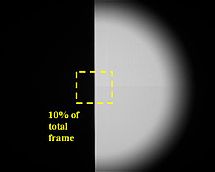- Modulation transfer function (infrared imaging)
-
The Modulation Transfer Function (MTF) is used to approximate the position of best focus of an infrared imaging system. In an imaging system, best focus is typically achieved when the MTF is between 0.4 and 0.6; most often at 0.5 (50% cutoff frequency of the MTF) MTF is inversely related to the minimum resolvable temperature difference (MRTD), which is a measure of an infrared sensor's ability to resolve temperature difference. MTF is defined as the discrete fourier transform of the Line Spread Function (LSF). The LSF can be calculated by two different methods. One includes measuring the LSF directly from an idealized line approximation provided by an image of a slit target. The other involves differentiating the Edge Spread Function (ESF).[1]
Contents
ESF evaluation
An operator defines a box area encompassing the edge of a knife-edge test target image back-illuminated by a blackbody. The box area is defined to be approximately 10% of the total frame area. The image pixel data is translated into a two-dimensional array (pixel intensity and pixel position). The amplitude (pixel intensity) of each line within the array is normalized and averaged. This yields the edge spread function (ESF)[2]
where
- ESF = the output array of normalized pixel intensity data
 = the input array of pixel intensity data
= the input array of pixel intensity data = the ith element of
= the ith element of 
 = the average value of the pixel intensity data
= the average value of the pixel intensity data = the standard deviation of the pixel intensity data
= the standard deviation of the pixel intensity data = number of pixels used in average
= number of pixels used in average
LSF evaluation
The line spread function (LSF) can be found using two different methods. It can be found directly from an ideal line approximation provided by a slit test target or it can be derived from the ESF. Using the latter method, the LSF is defined as the first derivative of the ESF[3], which is differentiated using numerical methods.
Since the ESF can not be differentiated analytically, it is numerically approximated using the finite difference:
where
 = the index
= the index 
 =
=  position of the
position of the  pixel
pixel = ESF of the
= ESF of the  pixel
pixel
MTF Evaluation
The Modulation Transfer Function (MTF) is defined as the discrete fourier transform of the Line Spread Function. Thus, given the LSF, the MTF is approximated numerically. This data is graphed against the spatial frequency data. A sixth order polynomial is fitted to the MTF vs. spatial frequency curve to remove any trends. The 50% cutoff frequency is determined to yield the corresponding spatial frequency. Thus, the approximate position of best focus of the Unit Under Test is determined from this data.
MTF calculations
The Fourier transform of the LSF can not be determined analytically by the following equations:
Therefore, the Fourier Transform is numerically approximated using the discrete Fourier transform
 .[4]
.[4]where
 = the kth value of the MTF
= the kth value of the MTF = number of data points
= number of data points = index
= index = kth term of the LSF data
= kth term of the LSF data =
=  pixel position
pixel position
Since most computer software is not able to compute complex numbers directly, Euler's identity is implemented to break the transform into separate real and complex terms.
The MTF is then plotted against spatial frequency and all relevant data concerning this test can be determined from that graph.
See also
- Minimum Resolvable Contrast
- Minimum resolvable temperature difference
- Optical transfer function
- Signal transfer function
References
- ^ Holst, G.C. (1998). Testing and Evaluation of Infrared Imaging Systems (2nd ed.). Florida:JCD Publishing, Washington:SPIE.
- ^ Electro Optical Industries, Inc.(2005). EO TestLab Methodology. In Education/Ref. http://www.electro-optical.com/html/toplevel/educationref.asp.
- ^ Mazzetta, J.A.; Scopatz, S.D. (2007). Automated Testing of Ultraviolet, Visible, and Infrared Sensors Using Shared Optics. Infrared Imaging Systems: Design Analysis, Modeling, and Testing XVIII,Vol. 6543, pp. 654313-1 654313-14
- ^ Chapra, S.C.; Canale, R.P. (2006). Numerical Methods for Engineers (5th ed.). New York, New York: McGraw-Hill
External links
- SPIE international society advancing light based research.
- Electro Optical Industries infrared and visible light spectrum test and calibration equipment.
- MTF expressing the imaging quality.
- Quick MTF software for measuring resolution, including ESF, LSF and MTF.
- MTF on Optipedia Modulation transfer function written by Glenn D. Boreman on Optipedia.
- How to Measure MTF How to Measure MTF and other Properties of Lenses written by Optikos Corporation.
Categories:- Image processing
- Infrared imaging
- Optics
Wikimedia Foundation. 2010.






![\text{MTF} = \mathcal{F} \left[ \text{LSF}\right] \qquad \qquad \text{MTF}= \int f(x) e^{-i 2 \pi\, x s}\, dx](e/e5ec6e37fcbc93065d85e3a046e1ab7d.png)
![\text{MTF} = \mathcal{DFT}[\text{LSF}] = Y_k = \sum_{n=0}^{N-1} y_n e^{-ik \frac{2 \pi}{N} n} \qquad k\in [0, N-1]](5/4b51602463d006f52c125c60a55dfb79.png)


![\text{MTF}= \mathcal{DFT}[\text{LSF}] = Y_k = \sum_{n=0}^{N-1} y_n \left[\cos\left(k\frac{2 \pi}{N} n\right) - i\sin\left(k \frac{2 \pi}{N} n\right)\right] \qquad k\in[0,N-1]](0/0e02d3ad277afaff0fec766def27e56c.png)